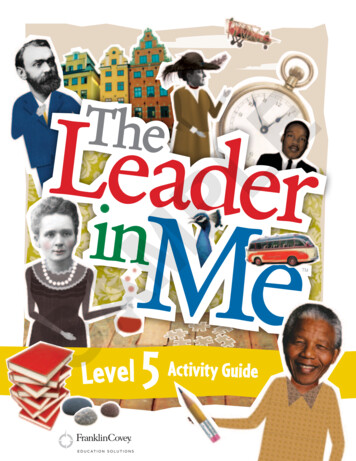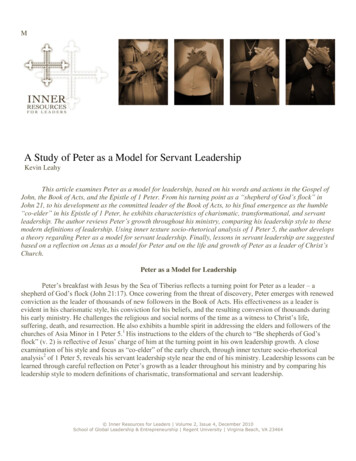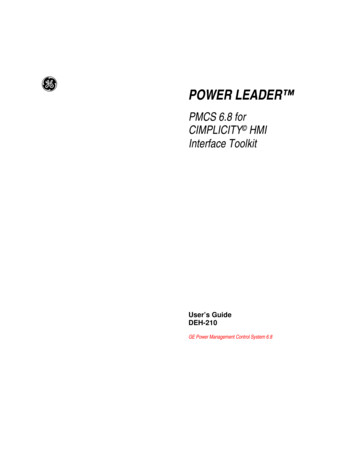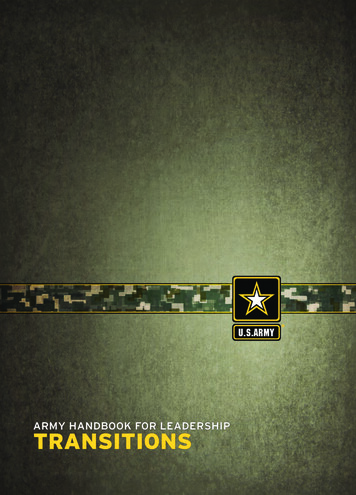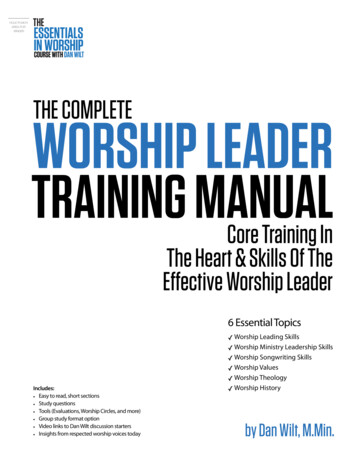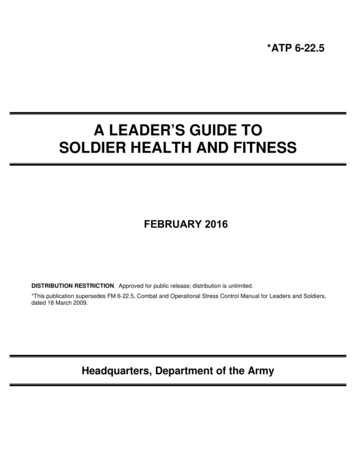
Transcription
*ATP 6-22.5A LEADER’S GUIDE TOSOLDIER HEALTH AND FITNESSFEBRUARY 2016DISTRIBUTION RESTRICTION. Approved for public release; distribution is unlimited.*This publication supersedes FM 6-22.5, Combat and Operational Stress Control Manual for Leaders and Soldiers,dated 18 March 2009.Headquarters, Department of the Army
This publication is available at Army Knowledge .html).To receive publishing updates, please subscribe athttp://www.apd.army.mil/AdminPubs/new subscribe.asp
*ATP 6-22.5HeadquartersDepartment of the ArmyWashington, DC, 10 February 2016Army Techniques Publication (ATP)No. 6-22.5A Leader’s Guide toSoldier Health and FitnessContentsPagePREFACE. vINTRODUCTION . viChapter 1READY AND RESILIENT CAMPAIGN . 1-1Section I — Medical Readiness . 1-1Behavioral Health . 1-1Posttraumatic Stress Disorder . 1-2Traumatic Brain Injury . 1-2Pain Management . 1-3Polypharmacy . 1-4Section II — Personnel Readiness . 1-4Suicide Prevention . 1-5Comprehensive Soldier and Family Fitness Program . 1-5Deployment Health Assessment Program . 1-5Individual Medical Readiness . 1-6Chapter 2PERFORMANCE TRIAD . 2-1Section I — Sleep . 2-1Sleep Management in the Operational Environment . 2-1Sleep Environment and Critical Factors Related to Good Sleep Hygiene . 2-2Sleep Loss . 2-5Section II — Activity . 2-7Physical Training Programs. 2-7Functional Fitness Program. 2-8Section III — Nutrition . 2-8Nutritional Guidance . 2-8Dietary Supplements . 2-9Hydration . 2-10Distribution Restriction: Approved for public release; distribution is unlimited.*This publication supersedes FM 6-22.5, Combat and Operational Stress Control Manual for Leaders andSoldiers dated 18 March 2009.i
ContentsChapter 3COMPREHENSIVE SOLDIER AND FAMILY FITNESS PROGRAM . 3-1Section I — Overview . 3-1Section II — Educational Resources. 3-2Chapter 4POTENTIALLY LIFE THREATENING THOUGHTS AND BEHAVIORS . 4-1Section I — Threat of Suicide . 4-1Section II — Threat of Violence to Others and the Risk of UnlawfulBehavior . 4-2Unit Risk Factors . 4-2Individual Risk Factors Affecting Soldiers . 4-3Individual Behaviors of Soldiers at Risk . 4-3Chapter 5ARMY HEALTH PROMOTION PROGRAM . 5-1Section I — Health Promotion Program . 5-1Section II — Behavioral Health . 5-2Behavioral Health Promotion . 5-2Stress Management . 5-2Combat and Operational Stress Control . 5-3Suicide Prevention . 5-3Responsible Sexual Behavior . 5-3Army Substance Abuse Program . 5-4Tobacco Cessation . 5-4Section III — Physical Health . 5-4Physical Fitness . 5-5Injury Prevention . 5-5Ergonomics . 5-5Oral Health . 5-6Body Composition Program . 5-6Chapter 6FIELD HYGIENE AND SANITATION. 6-1Section I — Health Threats to Soldiers in the Field. 6-1Section II — Soldier Preventive Medicine Measures . 6-2Personal Hygiene . 6-2Arthropods, Rodents, and Other Animal Threats . 6-3Section III — Field Sanitation Teams . 6-3Field Sanitation Team Protection and Sanitation Duties . 6-4Field Sanitation Team Arthropod and Rodent Control Duties . 6-4Section IV — Commander and Leader Preventive Medicine Measures . 6-5Chapter 7COMBAT AND OPERATIONAL STRESS REACTION IDENTIFICATION,PREVENTION, MANAGEMENT AND CONTROL . 7-1Section I — Reactions to Combat and Operational Stress . 7-1Section II — Forms of Combat and Operational Stress . 7-3Potentially Traumatic Events . 7-3Combat and Operational Stress Behaviors . 7-3Section III — Combat and Operational Stress Reactions . 7-5Section IV — Referral of Soldiers Experiencing Combat and OperationalStress Reactions and Other Stress-Related Disorders. 7-10iiATP 6-22.510 February 2016
ContentsVoluntary Referrals . 7-11Command-Directed Evaluation. 7-11Section V — Preventing and Managing Combat and Operational Stress 7-13Cohesion and Morale . 7-13Stress-Reduction Techniques for Leaders . 7-14Performance Degradation Preventive Measures . 7-17Section VI — Role of Religious Support . 7-18Section VII — Role of Unit Behavioral Assets . 7-19Mental Health Sections . 7-19Mental Health Section Functions . 7-20Chapter 8COMMAND LEADERSHIP ACTIONS AND COMBAT AND OPERATIONALSTRESS CONTROL PROGRAMS . 8-1Section I — Unit Behavioral Health Needs Assessment . 8-1Section II — Effective Leadership . 8-2Leaders are Reliable and Confident . 8-2Family Readiness Group . 8-6Section III — Traumatic Event Management and Leader-Led After ActionDebriefing . 8-11Traumatic Event Management . 8-11Cool Down Meetings . 8-13Leader-Led After Action Debriefing . 8-13Effectively Sustain Performance . 8-15Section IV — Effective Combat and Operational Stress Control. 8-17Minimize Stress . 8-17Mobilization . 8-17Deployment . 8-20Section V — Soldier Resiliency and Combat and Operational StressControl . 8-22Section VI — Leadership Actions and Interventions for Combat andOperational Stress Reactions . 8-23Section VII — Combat and Operational Stress Reaction ManagementGuidelines . 8-24Brevity . 8-24Immediacy . 8-24Contact . 8-25Expectancy . 8-25Proximity . 8-25Simplicity. 8-25Section VIII — Safety Considerations . 8-25Chapter 9BEHAVIOR AND PERSONALITY DISORDERS. 9-1Section I — Medical Readiness Responsibilities . 9-1Section II — Personality Disorders . 9-4Behavioral Health Status . 9-4Documenting Maladaptive Patterns of Behavior and Performance . 9-4Chapter 10POSTTRAUMATIC STRESS DISORDER . 10-110 February 2016ATP 6-22.5iii
ContentsChapter 11MILD TRAUMATIC BRAIN INJURY/CONCUSSION . 11-1Section I — Mild Traumatic Brain Injury Overview . 11-1Educate . 11-2Train . 11-2Treat . 11-2Track . 11-3Section II — Commander’s Guidance for Management of Mild TraumaticBrain Injury . 11-3GLOSSARY . Glossary-1REFERENCES. References-1INDEX . Index-1FiguresFigure 7-1. Combat and operational stress effect model . 7-2TablesIntroductory Table-1. Rescinded Army terms . viiTable 1-1. Symptoms of closed head injuries . 1-3Table 2-1. Basic sleep scheduling information . 2-2Table 2-2. Basic sleep environment and related factors. 2-3Table 2-3. Using caffeine under various conditions of sleep deprivation . 2-4Table 7-1. Combat stressors and operational stressors . 7-1Table 7-2. Adaptive stress reactions . 7-3Table 7-3. Mild stress reactions . 7-6Table 7-4. Severe stress reactions . 7-6Table 10-1. Symptoms of posttraumatic stress disorder . 10-1Table 11-1. Effects of mild traumatic brain injuries, or concussions, on the Soldierand combat mission. 11-1Table 11-2. Injury, evaluation, and distance checklist . 11-3Table 11-3. Common mild traumatic brain injury, or concussion, signs and symptoms . 11-4ivATP 6-22.510 February 2016
PrefaceArmy Techniques Publication (ATP) 6-22.5 provides commanders, leaders, and Soldiers with doctrine andtechniques to establish a climate that supports and encourages a holistic and collaborative effort to improveSoldier readiness and resilience. This publication includes physical and psychological health information andreferences pertaining to the United States (U.S.) Army Ready and Resilient Campaign, Performance Triad,Comprehensive Soldier and Family Fitness Program, and other behavioral health programs. Information andguidance is provided to establish a command climate that reduces the stigma associated with Soldiers seekingassistance with behavioral health issues, mild traumatic brain injury, and suicide or life-threatening thoughts.Continuous operations health issues are discussed to minimize Soldier performance degradation, sleepdeprivation, and nutritional deficits. This publication provides essential leader and Soldier information onbehavioral health issues including combat and operational stress control (COSC); combat and operational stressreaction identification, prevention, management, and control; command and leadership tools to minimize stressand build resilience; and information pertaining to the management of posttraumatic, postcombat, andoperational stress. The publication assists leaders in identifying risk factors and stressors associated withmilitary operations and describe leader actions and preventive measures designed to reduce or eliminateassociated risks and stressors. The publication covers the application of unit needs assessments, COSCmanagement techniques, and traumatic event management that help prevent, identify, and treat stress casualtiesin forward areas and minimize the long-term effects of combat and operational stress reactions. The inclusionof field hygiene and sanitation information is intended to provide leaders with a foundation to plan and executefield hygiene and sanitation practices to mitigate health threats and minimize personnel losses to disease andnonbattle injury.The principal audience for ATP 6-22.5 is commanders, their staffs, command surgeons, leaders, Soldiers, andArmy civilian personnel at all levels to ensure the health and fitness of the force.Commanders, staffs, and subordinates ensure their decisions and actions comply with applicable United States,international, and in some cases, host-nation laws and regulations. Commanders at all levels ensure theirSoldiers operate in accordance with the law of war and the rules of engagement (see Field Manual [FM] 27-10).Unless this publication states otherwise, masculine nouns and pronouns do not refer exclusively to men.Army Techniques Publication 6-22.5 uses joint terms where applicable. Selected joint and Army terms anddefinitions appear in both the glossary and the text. For definitions shown in the text, the term is italicized andthe number of the proponent publication follows the definition. This publication is not the proponent for anyArmy terms.Army Techniques Publication 6-22.5 applies to the Active Army, Army National Guard, Army National Guardof the United States, and United States Army Reserve unless otherwise stated.The proponent and the preparing agency of this publication is the United States Army Medical DepartmentCenter and School, United States Army Health Readiness Center of Excellence. Send comments andrecommendations on a DA Form 2028 (Recommended Changes to Publications and Blank Forms) toCommander, United States Army Medical Department Center and School, United States Army HealthReadiness Center of Excellence, ATTN: MCCS-FDL, (ATP 6-22.5), 2377 Greely Road, Building 4011,Suite D, JBSA Fort Sam Houston, Texas 78234-7731; by e-mail to rine@mail.mil; or submit an electronic DA Form 2028. All recommendedchanges should be keyed to the specific page, paragraph, and line number. A rationale should be provided foreach recommended change to aid in the evaluation of that comment.10 February 2016ATP 6-22.5v
IntroductionCurrent combat operations and a U.S. Army transformation resulted in an institutional shift in how leadersview, approach, and manage the effects of Soldier health, readiness, and resilience. Commanders areresponsible to establish and maintain an environment that encourages holistic efforts from leaders, Soldiersand Family to improve health, readiness, and resilience. Combat and operational stress control has alwaysbeen a commander’s program and to be successful, commanders must fully understand and appreciate themagnitude of a potentially traumatic event and its effect on exposed organizations and individuals. It is aharsh reality that combat and operational stress affects everyone engaged in unified land operations. NoSoldier or Family member remain unchanged. It should be viewed as a continuum of possible outcomesthat each person’s experience with a range from positive growth behavior to negative and sometimesdisruptive reactions. Effective leadership shapes the experience that they and their Soldiers go through inan effort to successfully transition units and individuals, build resilience and promote posttraumatic growth,or increased functioning and positive change after enduring trauma. Combat and operational stress controldoes not take away the experiences faced while engaged in military operations, it attempts to mitigate thoseexperiences so that Soldiers and units remain combat-effective and ultimately provide the support andmeaning allowing Soldiers to maintain the quality of life to which they are entitled.Army Techniques Publication 6-22.5 consists of 11 chapters as follows:Chapter 1 provides an overview of the Army’s Ready and Resilient Campaign that integrates andsynchronizes multiple Army health promotion and behavioral health initiatives. It provides leaders withinformation and resources specific to the medical aspects of the program.Chapter 2 is a new chapter that provides leaders with the resources and information on the Army’s SurgeonGeneral’s Performance Triad initiative to transform the Army Medical Department’s health care system toa system of health emphasizing wellness and preservation of health. This chapter discusses the three majorcomponents of the program—sleep, activity, and nutrition.Chapter 3 discusses the Comprehensive Soldier and Family Fitness Program and provides information andresources to assist leaders in improving the Soldier’s physical and psychological health.Chapter 4 provides information and resources pertaining to potentially life threatening behavioral changesthat may be present when a Soldier, Family member, or Army Civilian may be exhibiting suicidal behavior.Chapter 5 provides leaders with information and resources pertaining to the Army Health PromotionProgram. This chapter focuses on the integration of preventive and public health practices to maximizereadiness, resilience, and performance.Chapter 6 provides information and references for leaders to prevent disease and nonbattle injury witheffective preventive medicine measures and command involvement.Chapter 7 provides leaders with information and references to successfully implement a COSC program.This chapter discusses combat and operational stress reaction identification and techniques for leaders toprevent or manage stress.Chapter 8 describes leadership requirements and actions to support combat and operational stress controlprograms. It provides information on unit behavioral health needs assessments and methods to techniquesto minimize stress within the organization with an effective COSC program.Chapter 9 discusses behavior and personality disorders that may represent a health condition that limits theSoldier’s physical or psychological ability to plan, train, or execute their mission.Chapter 10 provides leaders with information pertaining to posttraumatic stress disorder (PTSD). Leadersare provided information on symptoms of PTSD and resources to assist Soldiers in obtaining assistance.viATP 6-22.510 February 2016
IntroductionChapter 11 provides leaders with an overview on mild traumatic brain injuries programs, policy guidance,mild traumatic brain injury identification, and medical guidance.Introductory Table-1. Rescinded Army termsTermbattlemindbattlemind warrior resilience10 February 2016RemarksDeletedDeletedATP 6-22.5vii
This page intentionally left blank.
Chapter 1Ready and Resilient CampaignThis chapter discusses the U.S. Army Ready and Resilient Campaign’s objective tointegrate and synchronize multiple Army health promotion and behavioral healthinitiatives. The campaign’s objective is to enhance unit and individual readiness andresilience by improving upon the physical, emotional and psychological resilience ofSoldiers, Families, and Army Civilians. The campaign integrates and synchronizesmultiple Armywide initiatives such as the Performance Triad program,Comprehensive Soldier and Family Fitness, and other health and behavioral healthprograms, discussed in later chapters of this book, to enhance unit readiness andimprove Soldier readiness and resilience.SECTION I — MEDICAL READINESS1-1. The physical and psychological health of Soldiers, Family and Army Civilians is a significant part ofthe U.S. Army Ready and Resilient Campaign. The Army Medical Department provides resources to assistSoldiers, Families, and Army Civilians to obtain treatment and provide guidance in matters includingbehavioral health, PTSD, traumatic brain injury, pain management, and polypharmacy.BEHAVIORAL HEALTH1-2. The Army’s current behavioral health system is in the process of transforming its model of care to anenhanced proactive and integrated patient-centered system of care. The transformation to a behavioralhealth system of care provides standardized naming and function alignment, centralized resourcemanagement, continuous improvement through standardized metrics, and provides a review and analysisprocess. The new behavioral health system of care provides the following resources: Embedded Behavioral Health—Behavioral health personnel are aligned with units deliveringbehavioral health services in close proximity to the Soldier’s unit. For additional information onthis subject refer to the Army Medicine, Embedded Behavioral Health Web site identified in thereferences section of this publication. Tele-Behavioral Health—Provides behavioral health services through the use of technology todeliver clinical behavior health services at a distance via electronic communication systems. Foradditional information on this subject refer to the Army Medicine, Tele-Behavioral Health Website identified in the references section of this publication. Addictions Medications Residential Treatment—Provides residential care for individuals withsubstance abuse disorders. Addictions Medications Intensive Outpatient Program—Provides treatment for substance abusedisorders that exceed the treatment capability of outpatient care in the Army Substance AbuseProgram. Outpatient is a person receiving medical/dental examination and/or treatment frommedical personnel and in a status other than being admitted to a hospital. Included in thiscategory is the person who is treated and retained (held) in a medical facility (such as Role 2facility) other than a hospital (FM 4-02). For additional information on the subject refer to theArmy Substance Abuse Program Web site identified in the references section of this publication. Psychological Health Intensive Outpatient Program—Provides treatment for patient that displaypsychological conditions exceeding the outpatient treatment capabilities but does not requireinpatient hospitalization. A patient is a sick, injured or wounded Soldier who receives medicalcare or treatment from medically trained personnel (FM 4-02).10 February 2016ATP 6-22.51-1
Chapter 1 Multi-Disciplinary Outpatient Behavioral Health Clinic—Provides routine outpatient behavioralhealth services, neuropsychology, forensics, and support to Warrior Transition Units, and otheroutpatient missions.Inpatient Behavioral Health—Provides inpatient behavioral health service to address acute crisisand rapid symptom resolution to support safe transfer of care to outpatient settings.School Behavioral Health—Provides early intervention of behavioral health service to militarychildren.Child and Behavioral Health Services—Provides outpatient behavioral health care andconsultation and education to active duty Family members to create a behavioral health system ofcare promoting healthy, strong children and Families. For additional information on this subjectrefer to the Army Medicine, Child, Adolescent, and Family Behavioral Health Service Web siteidentified in the references section of this publication.Family Advocacy Program—Prevents and provides care for victims of domestic violence orneglect and provides marriage and Family therapy programs. This resource may also providebehavioral health personnel trained in sexual assault response and victim treatment. Foradditional information on this subject refer to the Army Medicine, Family Advocacy ProgramWeb site (identified in the references section of this publication) and Army Regulation (AR)608-18. For doctrinal information pertaining to the employment and capabilities of behavioralhealth resources in brigade combat teams as well as COSC detachments refer to ATP 4-02.3.POSTTRAUMATIC STRESS DISORDER1-3. Posttraumatic stress disorder is an anxiety disorder that can occur following a traumatic event such ascombat, disasters, accidents or other life threatening events in which there was a threat of injury or death toyou or someone else. All Soldiers have reactions after combat. These reactions are normal andusually resolve quickly. Typical symptoms include hypervigilance, intrusive thoughts, flashbacks,numbness, avoidance, and nightmares. Posttraumatic stress disorder is treatable and with the proper carethe Soldier or patient returns to a healthy, productive and satisfying life. For additional information on thissubject refer to Chapter 10 of this publication and the Army Medicine, Behavioral Health Web sit
A LEADER’S GUIDE TO SOLDIER HEALTH AND FITNESS . FEBRUARY 2016. DISTRIBUTION RESTRICTION. Approved for public release; distribution is unlimited. *This publication supersedes FM 6-22.5, Combat and Operational Stress Control Manual for Leaders and Soldiers,


